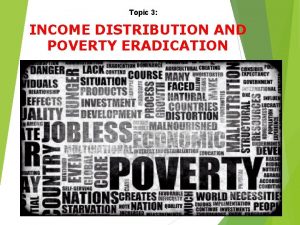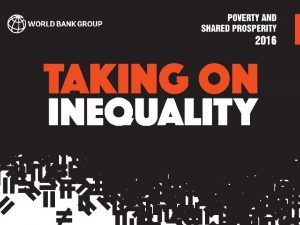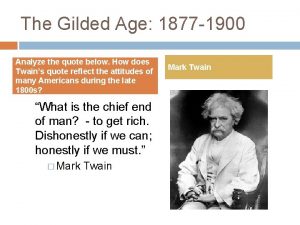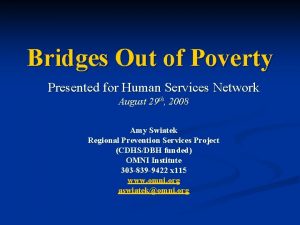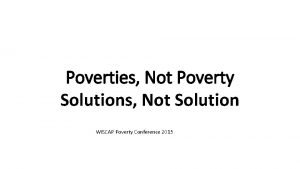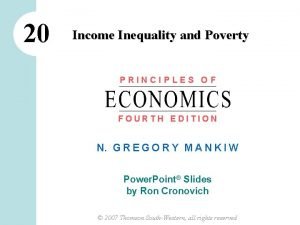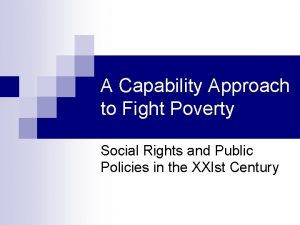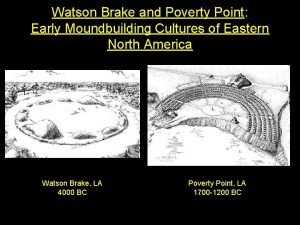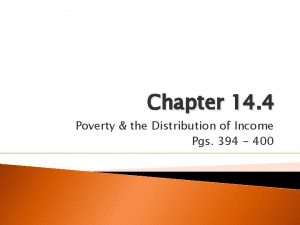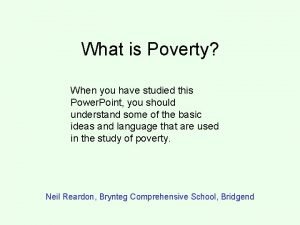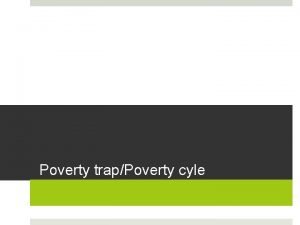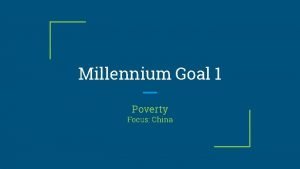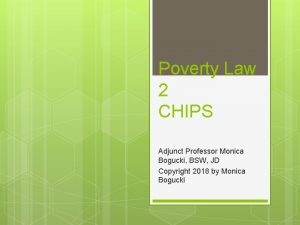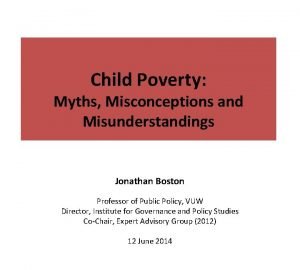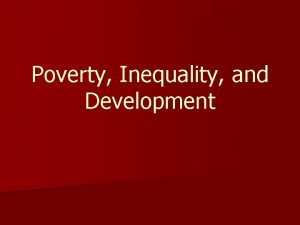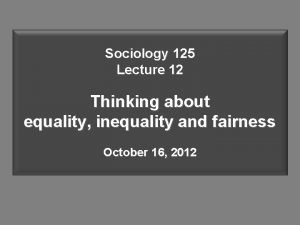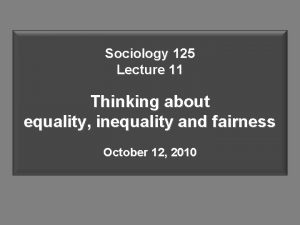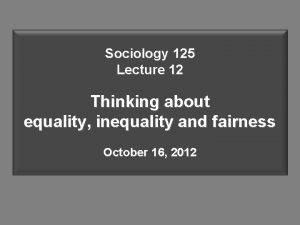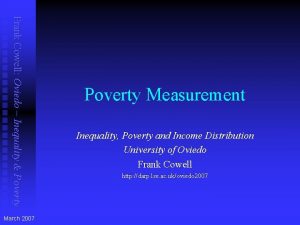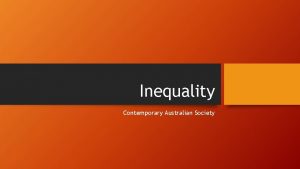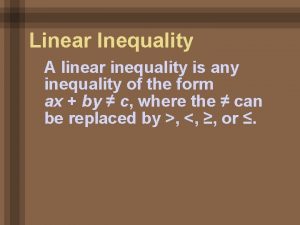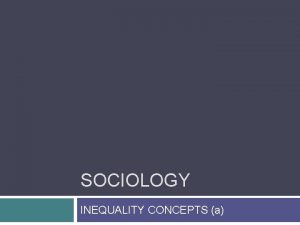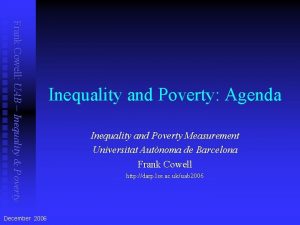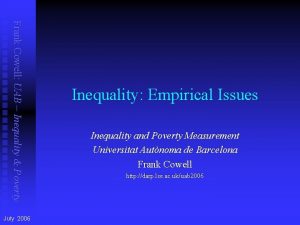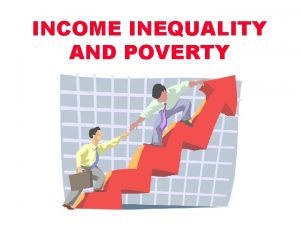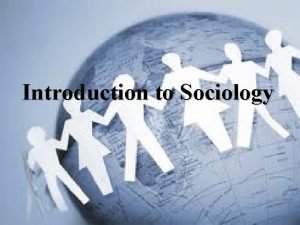Sociology 125 Lecture 14 Poverty Inequality March 7











































- Slides: 43

Sociology 125 Lecture 14 Poverty & Inequality March 7, 2017

Recapitulation: THREE APPROACHES TO CLASS Class concept Key Idea Individual attributes One person’s class position does not affect anyone else’s Opportunity-hoarding The advantages of being in a privileged class position causally depend on the disadvantages of others (“exclusion”) Domination & exploitation The advantages of being in a privileged class position causally depend on two things: exclusion and controlling the activities of others.

THE COMPOSITE AMERICAN CLASS STRUCTURE 1. An extremely rich capitalist/corporate managerial class 2. Historically a large and stable middle class anchored in possession of educational credentials, with an uncertain future. 3. A working class that was once supported by a strong labor movement with living standards overlapping the middle class, but now quite vulnerable. 4. The working poor: A poor segment of the working class, with low wages, unconstrained competition, high vulnerability. 5. The underclass: A marginalized population living in desperate poverty.

An Empirical Profile of Inequality in America

Household net Financial Assets 19% 53% om t t o 90% B 15% 42% 28% 43% Richest 1 % Household income Richest 1% of households Next richest 9% of households Bottom 90% of households Distribution of Household Income and Wealth, 2010

The Great U-Turn in Inequality

The Great U-Turn in Inequality

The Great U-Turn in Inequality 22. 5% 9%

Annual rate of growth of family income by income group 1947 -79 compared to 1979 -2005 1979 -2012 140% 120% 100% 75% 80% 60% 49% 40% 20% 0% -20% 8% 20% -12% 0% Lowest Second Third Fourth Highest Top 5 fifth fifth percent

Top 1% compared to middle Just below top 1% compared to middle Middle compared to bottom 20%

Earnings Growth at the Very Top of the Income Distribution 1972 -2001

Ratio of Average CEO to Average Worker pay, 1965 -2007 350 300 250 200 150 100 50 0 1965 1972 1978 1989 1997 2000 From Mishel, et. al. The State of working America, 2008 -09, Figure 3 AE 2005

Ratio of executive pay to Average worker pay 1940 s-2000 s 700 times the pay of average workers 600 Executives = 3 highest paid officers in companies that were among the 50 largest in 1940, 1960, or 1990 500 Top 10% of executives 400 300 Median executive Bottom 10% of executives 200 1940 1950 1960 1970 1980 1990 2000 Source: New York Times 4/8/2006

Class Origins of People in the “Forbes 400” list of wealthiest people in the U. S.

An Empirical Profile of Poverty in America

Relative Poverty Rates (% with income <. 5 national median) 17. 3% United States Australia 14. 6% Canada 12. 0% OECD 11. 0% United Kingdom 11. 0% Germany 8. 9% Luxembourg 8. 5% Sweden 8. 4% Finland 8. 0% Norway 7. 8% France 7. 2% Netherlands 7. 2% 0% 5% 10% Poverty Rate 15% 20%

Changes in Child Poverty Rate and National Income, 1959 -2013 45 GDP per capita 50, 000 40 40, 000 35 30 25 Children under 6 20 15 30, 000 20, 000 Children under 18 10 10, 000 5 0 1959 1964 1969 1974 1979 1984 1989 1994 1999 2004 2009 - GDP per capita (2009 constant chained dollars) Percent of children living below the poverty line 50

Growth of intense poverty: % of poor living below half of the poverty line

Poverty rate within groups 40% Black: Black 21% of all poor people in 35% 30% 25% Hispanic: Hispanic 28% of all poor people in 2011 20% 15% 10% 5% White, non-Hispanic: 42% of all poor people in 0% 1973 1980 1987 1994 2001 2008 Poverty Rates by race and Ethnicity, 1973 -2011

Two broad types of explanations of persistent poverty: 1. Blame the victim 2. Blame society

Blame the Victim Basic idea: The problem is in the attributes of poor people; the solution is to change the person, not the society.

Blame the victim Simple reasoning: 1. Some people who are born poor become rich, others do not, sometimes even within a family. 2. There must be something different between those who stay poor and those who do not which explains the different outcomes. 3. Therefore the explanation of poverty must be this individual difference: there must be a personal deficit of some sort.

Blame the victim Simple reasoning: 1. Some people who are born poor become rich, others do not, sometimes even within a family. 2. There must be something different between those who stay poor and those who do not which explains the different outcomes. 3. Therefore the explanation of poverty must be this individual difference: there must be a personal deficit of some sort.

Blame the victim Simple reasoning: 1. Some people who are born poor become rich, others do not, sometimes even within a family. 2. There must be something different between those who stay poor and those who do not which explains the different outcomes. 3. Therefore the explanation of poverty must be this individual difference: there must be a personal deficit of some sort.

Ideological attractiveness of BTV to people with advantages: A painless way of explaining social problems that does not threaten people on the top.

Blame Society Basic idea: Circumstances vary much more between the poor and the non-poor do than personalities, motivations or values.

Middle class people vs poor people 1. Motivations: delayed gratification is an issue for both poor and middle class, e. g. credit card debt 2. Crime: white collar crime (eg. tax evasion) at least as prevalent as crimes of the poor.

Middle class people vs poor people 1. Motivations: delayed gratification is an issue for both poor and middle class, e. g. credit card debt 2. Crime: white collar crime (e. g. tax evasion) is at least as prevalent as crimes of the poor.

Basic take-home message: Even when individual attributes are relevant to explaining poverty, they are never a sufficient explanation.

SOCIAL STRUCTURAL EXPLANATIONS OF INEQUALITY AND POVERTY 1. Marginalization: Exclusion from labor markets 2. Inequality processes within labor markets 3. Processes which generate inequality in wealth

Social Structural causes of inequality and poverty: #1 Marginalization Definition: the process of being excluded from stable participation in the labor force. Three issues: 1. Simple observation: lack of adequate employment for people with low skills or with outmoded skills. 2. This is NOT just a problem of inadequate skill formation. It is equally a problem of inadequate job creation. 3. The consequences of marginalization are intensified because of lack of real safety-net.

Social Structural causes of inequality and poverty: #1 Marginalization Definition: the process of being excluded from stable participation in the labor force. Three issues: 1. Simple observation: lack of adequate employment for people with low skills or with outmoded skills. 2. This is NOT just a problem of inadequate skill formation. It is equally a problem of inadequate job creation. 3. The consequences of marginalization are intensified because of lack of real safety-net.

Social Structural causes of inequality and poverty: #1 Marginalization Definition: the process of being excluded from stable participation in the labor force. Three issues: 1. Simple observation: lack of adequate employment for people with low skills or with outmoded skills. 2. This is NOT just a problem of inadequate skill formation. It is equally a problem of inadequate job creation. 3. The consequences of marginalization are intensified because of lack of real safety-net.

Social Structural causes of inequality and poverty: #1 Marginalization Definition: the process of being excluded from stable participation in the labor force. Three issues: 1. Simple observation: lack of adequate employment for people with low skills or with outmoded skills. 2. This is NOT just a problem of inadequate skill formation. It is equally a problem of inadequate job creation. 3. The consequences of marginalization are intensified because of lack of real safety-net.

Poverty Rates before & after income transfers Pre-transfer poverty rate Post-transfer poverty rate

Social Structural causes of inequality: #2. Inequalities within labor markets a) Two possible ways of organizing the process of connecting wages to jobs: 1. Individualized competition 2. Labor market governed by rules which dampen competition b) Why does intensification of competitiveness (deregulation) lead to increasing inequality? c) Explanation for intensification of competition in the U. S. A. : • Decline of unions • Decline of government regulation • Increased global competition d) Technological change

Social Structural causes of inequality: #2. Inequalities within labor markets a) Two possible ways of organizing the process of connecting wages to jobs: 1. Individualized competition 2. Labor market governed by rules which dampen competition b) Why does intensification of competitiveness (deregulation) lead to increasing inequality? c) Explanation for intensification of competition in the U. S. A. : • Decline of unions • Decline of government regulation • Increased global competition d) Technological change

Social Structural causes of inequality: #2. Inequalities within labor markets a) Two possible ways of organizing the process of connecting wages to jobs: 1. Individualized competition 2. Labor market governed by rules which dampen competition b) Intensification of competitiveness (deregulation) leads to increasing inequality. c) Explanation for intensification of competition in the U. S. A. : • Decline of unions • Decline of government regulation • Increased global competition d) Technological change

Social Structural causes of inequality: #2. Inequalities within labor markets a) Two possible ways of organizing the process of connecting wages to jobs: 1. Individualized competition 2. Labor market governed by rules which dampen competition b) Intensification of competitiveness (deregulation) leads to increasing inequality. c) Explanation for intensification of competition in the U. S. A. : • Decline of unions • Decline of government regulation • Increased global competition d) Technological change

Social Structural causes of inequality: #2. Inequalities within labor markets a) Two possible ways of organizing the process of connecting wages to jobs: 1. Individualized competition 2. Labor market governed by rules which dampen competition b) Intensification of competitiveness (deregulation) leads to increasing inequality. c) Explanation for intensification of competition in the U. S. A. • Decline of unions • Decline of government regulation • Increased global competition d) Technological change

Social Structural causes of inequality: #3 Wealth inequality 1. Difficult for average person to accumulate much wealth through savings. 2. Stagnation of household income since the early 1970 s means that discretionary income for most people has not grown much. 3. Fantastic rise in employment earnings at high end of market has allowed professionals and managers to turn surplus earnings into capitalist wealth (stocks, bonds, etc. )

Social Structural causes of inequality: #3 Wealth inequality 1. Difficult for average person to accumulate much wealth through savings. 2. Stagnation of household income since the early 1970 s means that discretionary income for most people has not grown much. 3. Fantastic rise in employment earnings at high end of market has allowed professionals and managers to turn surplus earnings into capitalist wealth (stocks, bonds, etc. )

Social Structural causes of inequality: #3 Wealth inequality 1. Difficult for average person to accumulate much wealth through savings. 2. Stagnation of household income since the early 1970 s means that discretionary income for most people has not grown much. 3. Fantastic rise in employment earnings at high end of market has allowed professionals and managers to turn surplus earnings into capitalist wealth (stocks, bonds, etc. )
 What is absolute poverty
What is absolute poverty Inequality and poverty
Inequality and poverty Poland national anthem lyrics
Poland national anthem lyrics Lesson 1-6 compound inequalities
Lesson 1-6 compound inequalities Sociology lecture
Sociology lecture Environmental sociology lecture notes
Environmental sociology lecture notes 01:640:244 lecture notes - lecture 15: plat, idah, farad
01:640:244 lecture notes - lecture 15: plat, idah, farad Low income poverty
Low income poverty No poverty
No poverty End furniture poverty
End furniture poverty Catholic teaching on poverty
Catholic teaching on poverty Poverty and hunger solutions
Poverty and hunger solutions My experience with poverty
My experience with poverty Ireland famine 1729
Ireland famine 1729 Gilded age mark twain quote
Gilded age mark twain quote Symbolic interactionist perspective on poverty
Symbolic interactionist perspective on poverty Poverty reduction workgroup
Poverty reduction workgroup Www serp ap gov in mobile bookkeeping
Www serp ap gov in mobile bookkeeping Mental model of poverty
Mental model of poverty Poverty quiz
Poverty quiz Solution
Solution The causes of poverty
The causes of poverty Situational poverty definition
Situational poverty definition Poverty amidst plenty
Poverty amidst plenty Generational poverty
Generational poverty Ways to reduce poverty
Ways to reduce poverty St vinny
St vinny Conclusion of poverty
Conclusion of poverty Relative and absolute poverty
Relative and absolute poverty Sailmaker revision
Sailmaker revision Simon moss global poverty project
Simon moss global poverty project Situational poverty definition
Situational poverty definition Poverty point definition
Poverty point definition End furniture poverty
End furniture poverty Poverty of the stimulus
Poverty of the stimulus Poverty proofing
Poverty proofing Poverty poor health
Poverty poor health A framework for understanding poverty summary
A framework for understanding poverty summary Pictures of poverty
Pictures of poverty Cycle of poverty
Cycle of poverty Poverty causes
Poverty causes Adjunct poverty definition
Adjunct poverty definition Claim about poverty
Claim about poverty Child poverty in massachusetts
Child poverty in massachusetts
